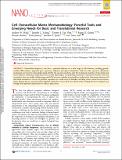| dc.contributor.author | Holle, Andrew W. | |
| dc.contributor.author | Young, Jennifer L. | |
| dc.contributor.author | Discher, Dennis | |
| dc.contributor.author | Janmey, Paul | |
| dc.contributor.author | Spatz, Joachim P. | |
| dc.contributor.author | Saif, Taher | |
| dc.contributor.author | Van Vliet, Krystyn J | |
| dc.contributor.author | Kamm, Roger Dale | |
| dc.date.accessioned | 2018-12-13T15:55:35Z | |
| dc.date.available | 2018-12-13T15:55:35Z | |
| dc.date.issued | 2017-11 | |
| dc.identifier.issn | 1530-6984 | |
| dc.identifier.issn | 1530-6992 | |
| dc.identifier.uri | http://hdl.handle.net/1721.1/119636 | |
| dc.description.abstract | Extracellular biophysical cues have a profound influence on a wide range of cell behaviors, including growth, motility, differentiation, apoptosis, gene expression, adhesion, and signal transduction. Cells not only respond to definitively mechanical cues from the extracellular matrix (ECM) but can also sometimes alter the mechanical properties of the matrix and hence influence subsequent matrix-based cues in both physiological and pathological processes. Interactions between cells and materials in vitro can modify cell phenotype and ECM structure, whether intentionally or inadvertently. Interactions between cell and matrix mechanics in vivo are of particular importance in a wide variety of disorders, including cancer, central nervous system injury, fibrotic diseases, and myocardial infarction. Both the in vitro and in vivo effects of this coupling between mechanics and biology hold important implications for clinical applications. | en_US |
| dc.description.sponsorship | National Science Foundation (U.S.) | en_US |
| dc.publisher | American Chemical Society (ACS) | en_US |
| dc.relation.isversionof | http://dx.doi.org/10.1021/ACS.NANOLETT.7B04982 | en_US |
| dc.rights | Article is made available in accordance with the publisher's policy and may be subject to US copyright law. Please refer to the publisher's site for terms of use. | en_US |
| dc.source | ACS | en_US |
| dc.title | Cell–Extracellular Matrix Mechanobiology: Forceful Tools and Emerging Needs for Basic and Translational Research | en_US |
| dc.type | Article | en_US |
| dc.identifier.citation | Holle, Andrew W. et al. “Cell–Extracellular Matrix Mechanobiology: Forceful Tools and Emerging Needs for Basic and Translational Research.” Nano Letters 18, no. 1 (December 6, 2017): 1–8. © 2017 American Chemical Society | en_US |
| dc.contributor.department | Massachusetts Institute of Technology. Department of Biological Engineering | en_US |
| dc.contributor.department | Massachusetts Institute of Technology. Department of Materials Science and Engineering | en_US |
| dc.contributor.department | Massachusetts Institute of Technology. Department of Mechanical Engineering | en_US |
| dc.contributor.mitauthor | Van Vliet, Krystyn J | |
| dc.contributor.mitauthor | Kamm, Roger Dale | |
| dc.relation.journal | Nano Letters | en_US |
| dc.eprint.version | Final published version | en_US |
| dc.type.uri | http://purl.org/eprint/type/JournalArticle | en_US |
| eprint.status | http://purl.org/eprint/status/PeerReviewed | en_US |
| dc.date.updated | 2018-12-05T18:23:02Z | |
| dspace.orderedauthors | Holle, Andrew W.; Young, Jennifer L.; Van Vliet, Krystyn J.; Kamm, Roger D.; Discher, Dennis; Janmey, Paul; Spatz, Joachim P.; Saif, Taher | en_US |
| dspace.embargo.terms | N | en_US |
| dc.identifier.orcid | https://orcid.org/0000-0001-5735-0560 | |
| dc.identifier.orcid | https://orcid.org/0000-0002-7232-304X | |
| mit.license | PUBLISHER_POLICY | en_US |
